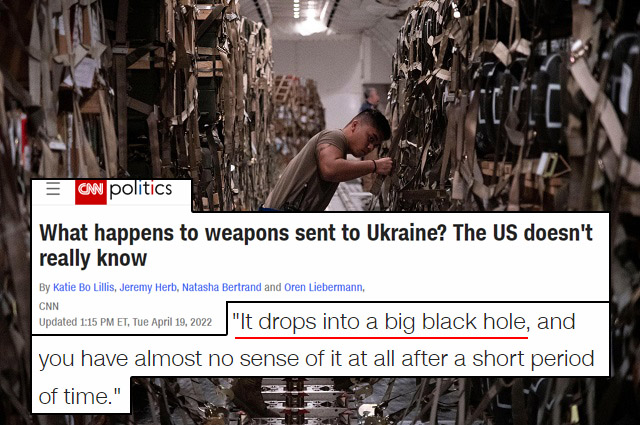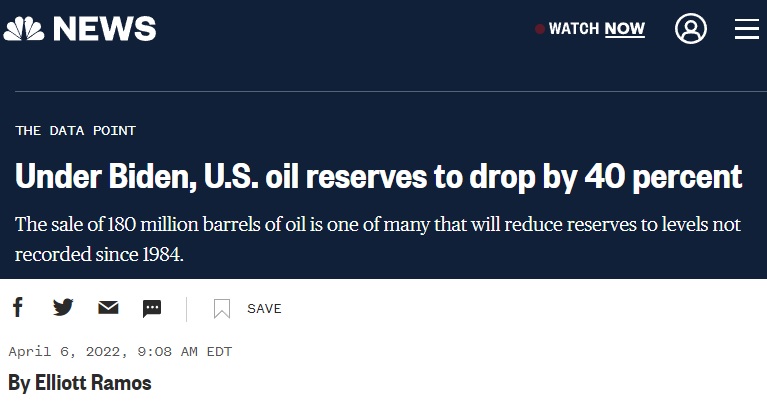Biden to Send Yet Another 'Large' Military Aid Package Into 'Black Hole' in UkraineChris MenahanInformationLiberation Apr. 20, 2022 |
Popular 
Only 15 Senators Vote to Block Arms to Israel, Despite Majority of Americans Wanting Aid to End

IDF Gunned Down Gaza Paramedics in Clearly Marked Emergency Vehicles, Recovered Video Shows

Key October 7th 'Mass Rapes' Witness Featured in Sheryl Sandberg Film 'Exposed as a Serial Liar'

Sen. Schumer: 'My Job is to Keep the Left Pro-Israel'

Rabbi Tells Senate Hearing It's 'Not Enough' to Be 'Not Anti-Semitic' - 'One Must Be Anti-Anti-Semitic'
  The Biden regime is dumping billions of dollars worth of scarce American high-tech weaponry into a "black hole" in Ukraine. The Biden regime is dumping billions of dollars worth of scarce American high-tech weaponry into a "black hole" in Ukraine. From Reuters, "Biden admin preparing to announce another military aid package for Ukraine": The Biden administration is preparing to announce another substantial military aid package for Ukraine this week, five U.S officials tell NBC News. Three officials said the package is expected to be similar in size to the $800 million one the administration announced last week.If this latest package is another $800 million, that means the Biden regime together with our sold-out Congress will have sent Ukraine around $15.2 billion in aid just since the war kicked off on Feb 24. Americans are struggling with record inflation and yet the DC regime just keeps dumping our money into this black hole knowing full well it could spark World War III.
The Washington Post admitted earlier this month that NATO is intentionally seeking to prolong the conflict in Ukraine just to drag down Russia as part of a proxy war. This "aid" is essentially just bribe money to Zelensky to keep the war going and keep Ukrainians dying. From CNN on Tuesday, "What happens to weapons sent to Ukraine? The US doesn't really know": The US has few ways to track the substantial supply of anti-tank, anti-aircraft and other weaponry it has sent across the border into Ukraine, sources tell CNN, a blind spot that's due in large part to the lack of US boots on the ground in the country -- and the easy portability of many of the smaller systems now pouring across the border.Tons of these weapons are going straight to the black market, others are falling into Russian hands and others are apparently being blown up upon arrival in Russian air strikes.
Each Javelin the US produces costs $178,000. It was reported last week that the US has already sent an estimated one-third of our stockpile to Ukraine. From Business Insider, "Will the US run out of Javelin anti-tank missiles to give Ukraine before Russia runs out of tanks?": The United States has not published figures about its Javelin inventory, so this must be deduced. According to the Army budget books, total production has been 37,739 since production began in 1994.The US has also reportedly sent some 2,000 out of an estimated 8,000 stockpiled Stinger missiles to Ukraine. "In 2003, the last time the United States procured Stingers, production rates were stated as 275 with standard shifts (called '1-8-5') and 720 at maximum production rate. Production lead time was 24 months. That means it will take at least five years to replace the inventory drawdown (two years for lead time and three years for production)," BI reported. Biden is also rapidly depleting our strategic oil reserves.  High-ranking Democrats are pushing for the US to put boots on the ground in Ukraine (the French paper Le Figaro claimed a week ago US and UK soldiers are already there).
What moronic decision will our occupiers make next? Follow InformationLiberation on Twitter, Facebook, Gab, Minds, Parler and Telegram. |



